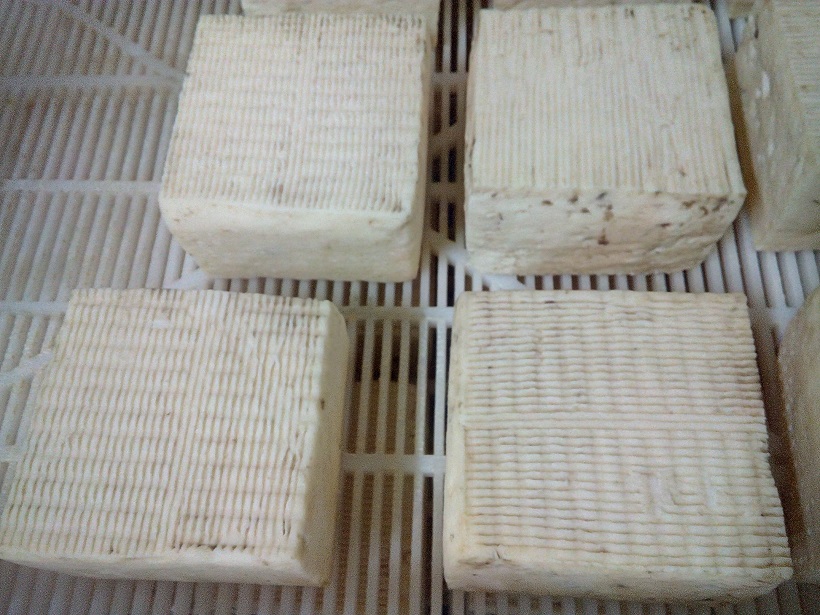Each cheese maker strives to ensure that the cheese he cooks has high quality and excellent taste. But it often happens that a product has defects. The main causes of cheese defects can be due to the low quality of raw materials (milk), some violations of technological processes associated with the production and storage of the product. Today we will talk about the main defects, defects of cheese and the reasons for their occurrence.
About milk
Everyone knows that cheeses are prepared on the basis of milk. Often the main cause of cheese defects are defects in raw milk. In order to avoid their appearance in a dairy product, first of all, it is necessary to observe sanitary conditions when milking cows. In addition, do not violate the rules of storage and transportation of milk. The most common product defects are of the following origin:
1. Feed. The smell and taste of garlic, onion, mustard, wormwood and buttercup are concentrated in the fat phase and are not eliminated by any technical methods. If these indicators are very pronounced in milk, it is not used in the food industry.
2. Bacterial. Such defects significantly impair the taste and smell of milk, change the consistency and color, which during storage progress. Defects can be as follows:
- milk turns sour under the influence of lactic acid bacteria;
- as a result of exposure to putrefactive bacteria during prolonged storage at low temperatures, milk acquires a bitter taste;
- putrid, musty taste in milk occurs as a result of exposure to peptizing bacteria from the group of Escherichia coli;
- colored spots in the product can be caused by specific groups of bacteria that form colored colonies of orange, blue, red, or when blood enters the milk from patients with mastitis.
It is possible to prevent the emergence of defects of this group with strict observance of SanPiN when receiving milk, timely primary processing, proper, and, most importantly, well-organized collection, storage and transportation.
3. Physico-chemical. Admixture in the product of old milk or colostrum, the addition of large doses of yeast, rennet, doses of calcium chloride.
4. Technical. Milk defects of technical origin can arise as a result of poor-quality or inept processing of the product. These include:
- mechanical contamination of milk - most often occurs if foreign particles get into the milk, such a product may contain pathogenic microflora;
- metallic taste - very often this defect can occur due to the fact that poorly tinned jars and other low-quality metal utensils are used.
Cheese defects and causes
These characteristics can be manifested in the deviation of organoleptic characteristics, packaging, chemical composition, labeling of products. In addition, cheese defects can occur when using poor quality raw materials, a violation of technology, as well as improper transportation and storage conditions. The following factors can influence the quality of cheese:
- professional qualities of the cheese maker;
- sanitary condition of tools and equipment;
- quality of yeast, enzymes, dyes.
According to the characteristics, four main groups of cheese defects can be distinguished:
- taste and smell;
- consistency;
- dough color;
- picture.
Major vices
Consider the most common defects inherent in cheese:
- Sour taste. The reason is the use of sour milk, a low ripening temperature, an excessive amount of sourdough, insufficient exposure of the product.
- The bitter taste. Products may have such a taste due to feed, the use of poor-quality salt, due to the low ripening temperature.
- Solid rough consistency. Cheese defects associated with this characteristic are formed due to the insufficient content of water in the cheese mass, low fat content of the cheese, in case of violation of the temperature regime when processing cheese mass.
- Friable consistency. Such products are obtained when using milk of high fat content and high acidity, in the presence of a large amount of water in the mass.
- The crumbly consistency. Occurs if the acidity is high and the cheese is mature. This defect can occur due to improper freezing and thawing of the product.
- Fistula. Deficiency is expressed in deep cracks that penetrate the head of the cheese, in some cases even through. Fistulas can be open and closed. Their appearance is due to improper formation and strong gas formation.
- Vices of cheese. Most often, with a violation of the ripening process, an uneven pattern is formed on the cheeses. Torn most often occurs due to rupture of partitions, in the event that large eyes are closely located. It is also possible as a result of violent gas formation.
- Deformation. Such a defect most often occurs when salting with dry salt without forms, in this case, the uncured cheese begins to settle and mutate. If cheese is stored at high temperatures, they can melt.
- The integrity of the crust. It happens that this defect arises from insects: larvae of a raw fly, a cheese tick. In addition, the cheese crust may be disturbed by rodents. Cracking the crust creates very favorable conditions for the development of mold inside the cheese.
- Creepy mold. This defect appears on the surface of the product in the form of small round spots of white color, if a strong rash occurs, then the crust can be completely destroyed.
- Vices of color. More often, the color of the dough has a white tint in cheese produced in winter, salted even if milk has a high acidity. Marble dough can occur due to uneven salting, milk entering the cheese mass from mastitis cows, or when using fresh grain obtained from a previous cooking.

Defects of processed cheese
Everyone who has at least a little idea about the production of processed cheese understands that quite a lot of factors can influence this process. Note that even small deviations can lead to quite serious defects, which begin to appear even when the cheese is melted. Some of them may appear some time after melting. The most common ones are:
- Weak smell and taste (arises due to the low maturity of raw materials). To avoid this defect in cheese, mature raw materials should be used.
- Unusual taste and smell. The reason - in the production of cheeses were used that have a ripened crust or affected by mold or mucus. Prevention consists in thorough washing and cleaning of cheeses. Vacuum melting.
- Fodder flavors. The feedstock has these characteristics. The defect can be eliminated by melting the raw materials under vacuum.
- The taste is bitter. It occurs when there is an excess of melting salts, magnesium salts, and high salt content in low-fat cheese in the feedstock. To avoid defect, better raw materials should be selected and the amount of low-fat fats reduced.
- Musty taste. It arises due to the low quality of the feedstock. After thorough processing, the raw materials must be placed in milk whey and the melting point increased to 95 ° C. Cool quickly and store at -3 ° C.
- Ammonia taste and smell. It occurs when using raw materials with excessive development of cheese mucus. Thorough washing and cleaning is recommended. Adding unsalted fresh cheese to raw materials .
- Sour taste and smell. Appear when using cottage cheese with high acidity. It is necessary to strictly follow the approved recipe.
- Rancid taste. Raw materials are used after a long time in the workshop. Long term storage should be excluded.
- Alkaline soapy taste. The use of excess baking soda and alkaline salt-melters.
- A greasy, musty taste. It is observed due to violation of the cooling and storage modes.

Vices of color cheese dough
Uneven coloring of the test can be attributed to this category. This is due to the fact that the hopper of the filling machine is filled from various automatic machines for melting with different colors. It is necessary to strictly observe the melting conditions. Another vice - intense dyeing (or browning) of the dough, occurs during prolonged curing of the cheese mass at a temperature of +85 .... + 90 ° . Packing and timely cooling of the finished product will help to prevent defect.
Vices of appearance and consistency
Such defects can be recognized visually. You can get rid of them relatively easily, you just have to strictly observe the entire technology of the process. Among these defects, the following should be highlighted:
- drawing (in the form of a grid) on the product;
- deformation of briquettes;
- the presence of mold on the cheese;
- uneven coloring;
- foil corrosion.
Vices of consistency:
- mealy;
- dense, brittle;
- coarse, hard;
- sticky, sticky;
- loose;
- unmelted grain in the dough.
Soft cheeses
The main cause of defects in soft cheeses is the failure to comply with the technological process and poor quality of raw materials. Why is the cheese crust damaged: is it dry, thick with cracks? The reasons are non-compliance with the conditions of maintenance and care of the product during the ripening period:
- high temperature (from +14 ° C);
- low humidity;
- drafts;
- excessive ventilation;
- moisture loss of the cheese mass during formation;
- poor development of mold or cheese mucus on the surface of the product.
Correcting this defect is easy - strict adherence to sanitary standards is necessary.
Fuzzy shape
Most often, this defect is found in cheeses with a very delicate texture. This is due to the production of cheese with high humidity, insufficient drying during self-pressing or untimely turning of cheese in the ripening process.
Mucus development
A cheese defect appears on the crust due to the insufficient drying of the cheese mass during the self-pressing process. In the event that the cheese is salted, usually a lot of liquid mucus is formed, it has a grayish-white color and an unpleasant odor. In order to prevent this defect, it is necessary to lay the product loosely on the shelves, remove excess mucus in a timely manner with a napkin, and also dry in chambers with a humidity of 85-87%.
Excess mold
If extraneous mold is suddenly found on the product, it is thoroughly washed. It is necessary to carry out disinfection and sanitization of the premises, inventory, equipment. In addition, the rules of personal hygiene and sanitation should be strictly observed.